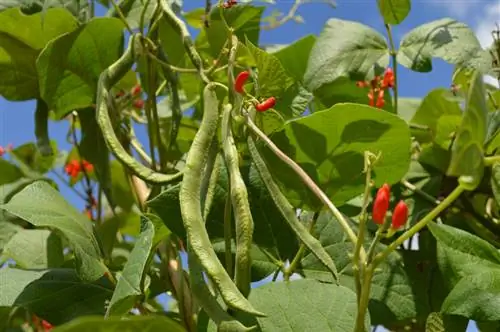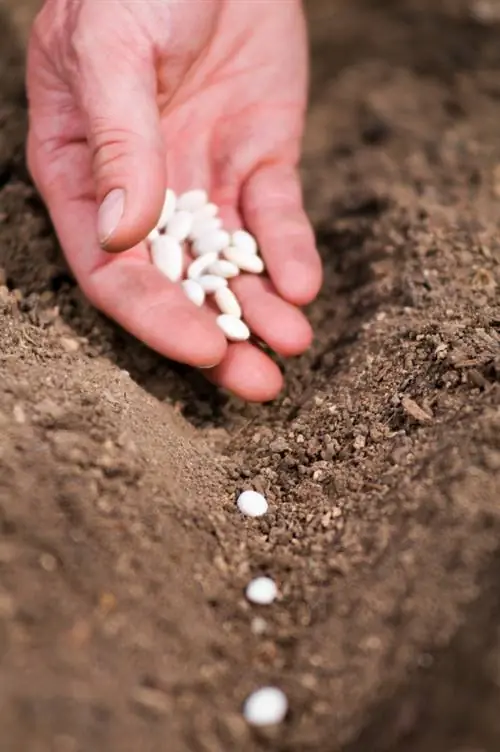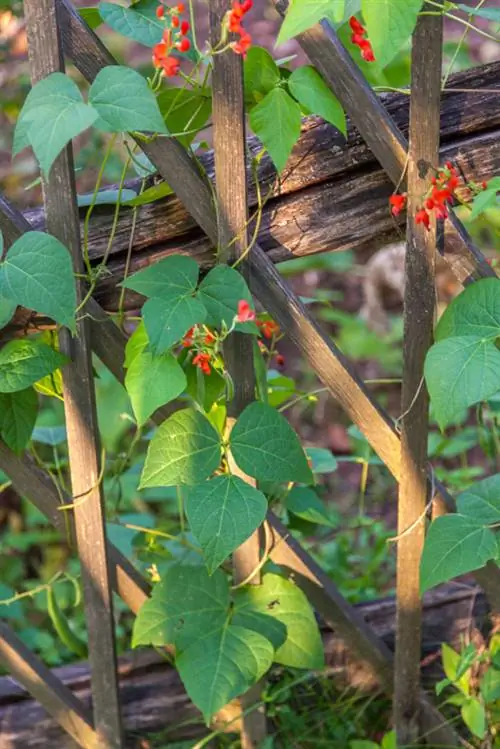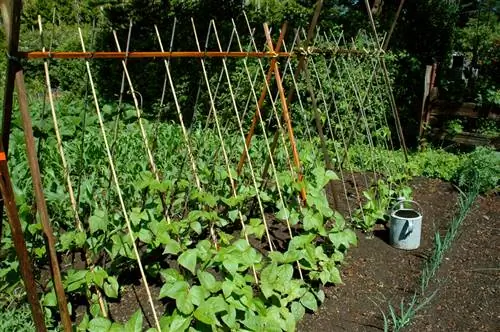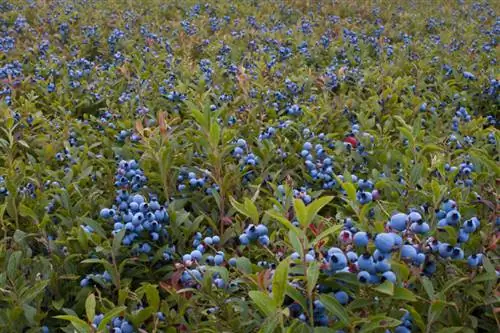- Author admin [email protected].
- Public 2023-12-25 17:45.
- Last modified 2025-01-23 11:20.
With a dress of flowers and leaves in poetic dimensions, runner beans climb meters high towards the sky. Their blazing floral fireworks display is followed by a tasty garnish of fruit, which has acquired the reputation of a culinary speci alty as runner beans. Find out here how the floral all-rounder can be cultivated professionally using tried-and-tested answers to frequently asked questions.
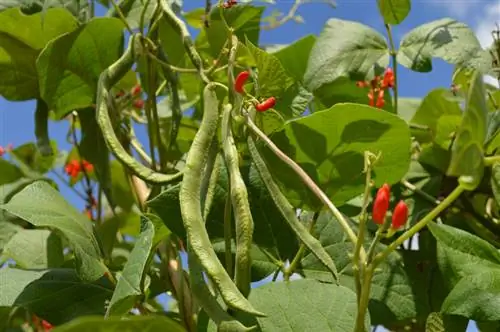
How do you properly care for runner beans?
Fire beans need a sunny to partially shaded location, humus-rich and well-drained soil and a climbing aid. They should be planted from mid-May, watered regularly and fertilized organically every 14 days. Only harvest the legumes after they have been heated to break down toxins.
Planting fire beans correctly
Red runner beans that have been bought ready-made or grown on the windowsill are so sensitive to cold that the planting time does not begin until early to mid-May at the earliest. First install the required climbing aid in a sunny to partially shaded location. Then loosen the soil until it is finely crumbly and dig small holes in it every 30-40 cm. Enrich the excavation with compost and a little sand before planting the young runner beans. After the first watering, spread a 5-6 cm high layer of mulch.read more
Care tips
With the following care program you can set the course for growing runner beans that leaves nothing to be desired:
- Hill freshly planted runner beans repeatedly from a height of 20 cm
- Keep the substrate and garden soil constantly moist with alternating soft and normal water
- Fertilize organically every 14 days from May until harvest
- Alternatively, water weekly with diluted nettle manure (ratio 1:10)
- Only clean up wilted flowers if no harvest is planned
The tropical scarlet runner beans thrive in the bed as an annual because they weaken at temperatures below 10 degrees Celsius. You are free to overwinter in pot culture. Move the plants that have been cut close to the ground into the darkened winter quarters in good time with temperatures of 10-12 degrees Celsius. Do not apply fertilizer and water rarely.
Which location is suitable?
Fire beans prefer a sunny to semi-shady location, preferably protected from strong winds. In particular, look for a location that has enough space for mounting a trellis. In any good garden soil, the tropical climbing artists develop rapid growth and rich flowers. A humus-rich, well-drained soil with a pH value of 5.5 to 7.5 is advantageous. Please ensure a crop rotation of at least 3 years.
What soil does the plant need?
Beetle beans achieve their floral optimum in a loamy-sandy, loose and humus-rich soil with a pH value of 5.5 to 7.5. The exotic beauties don't like a soil with a strong nutrient content, nor does a permanently wet location. If in doubt, mix a few handfuls of sand into clayey soil. For container cultivation, we recommend a peat-reduced, organic vegetable soil for carefree enjoyment of the aromatic legumes.
When is flowering time?
From June to September, runner beans give us a furious display of color with inflorescences up to 35 cm long. Now is the hour for pollinators to turn the opulent blossoms into a rich harvest of delicious runner beans. If you are only interested in the decorative value of this exotic climbing plant, cut off withered inflorescences as soon as possible to make room for new buds.
Watering runner beans
In a sunny location, runner beans evaporate a lot of moisture through their impressive leaves. Therefore, water regularly as soon as the surface of the bed soil and substrate has dried. Ideally, you should use soft rainwater and normal tap water alternately so that excess lime does not accumulate in the soil or the pH value rises to undesirable levels.
Fertilize fire beans properly
In contrast to the pronounced need for watering, runner beans prove to be frugal in terms of their nutrient balance. If you are aiming for a harvest of tasty legumes, we recommend organic fertilization with compost. From May until harvest, lightly work mature garden compost into the soil and water every 14 days. Specialist retailers have organic liquid fertilizer available for runner beans in the bucket (€9.00 on Amazon). Alternatively, from May onwards, administer nettle manure once a week, diluted with water in a ratio of 1:10.
Wintering
Given a temperature minimum of 10 degrees Celsius, runner beans thrive in beds in our latitudes as annual ornamental and useful plants. Cultivated in a bucket, there is still a chance of overwintering. Cut the wilted and harvested runner beans close to the ground and carry them to a frost-free winter quarters. At temperatures of 10-12 degrees Celsius, water occasionally to prevent the root ball from drying out. Fertilization is not carried out during dormant growth. After 2-3 years, the plant has formed a tuberous root system, similar to a dahlia. Take this out of the ground in autumn and store it dry in sand or newspaper in a cool, dark cellar until next May.
Propagate fire beans
Leave some runner beans on the plant in the fall to use the ripe seeds for propagation. Dried in an airy place, store the seeds in an airtight, dark screw-top jar in a cool cellar until next spring. Start sowing at the beginning of April following these short instructions:
- Roughen the thick, dried seeds a little with a file
- Soak in lukewarm water for 12-24 hours
- Insert 2-3 cm deep in pots with lean growing substrate and water
- Keep constantly moist in the heated indoor greenhouse at 20 degrees Celsius
You can optionally put a plastic cover over the potty and place it on the warm, partially shaded windowsill. Once germination begins, the cover has done its job and is removed. Until mid-May, care for the young runner beans with soft water. From a height of 10-12 cm, administer liquid fertilizer for vegetable plants diluted by half every 2 weeks.
Is runner beans poisonous?
Like all other types of beans, runner beans are not suitable for fresh consumption. Only heating to more than 75 degrees Celsius dissolves the toxins it contains. Until then, people and animals suffer symptoms of poisoning, such as nausea, vomiting, cramps and diarrhea. Be sure to grow runner beans out of the reach of children and pets. Since mere skin contact can trigger severe allergies, we recommend using gloves for all planting and care work.read more
Beautiful varieties
- Lady Di: A royal runner bean with red flowers and stringless beans; an ornamental and enjoyment plant in a class of its own
- Hesita: At 30 cm high, the ideal runner beans for the balcony and terrace with two-tone flowers in red and white
- Golden Sunshine: Visual highlight with red flowers over golden yellow foliage and delicious green legumes
- Magician: The variety produces purple, black-flecked beans, perfect for runner bean salad
- Bulgarian Snow Queen: Extravagant variety that stands out with white fruits and white seeds

